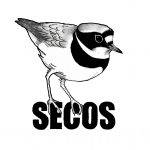The SECOS winter garden bird survey started in 1985 as an initiative by Colin Lythgoe and has continued to the present.
Each year an analysis of the records received has been used to produce an annual report document. Varying levels of survey support have been a feature. Initially, around about 20 gardens were recorded, but support dwindled to the extent that only ten gardens were being recorded by the early nineties. Happily, since then, support has gradually increased so that it is now usual for about 50 gardens to be regularly included. A significant factor in boosting the number of surveys was opening participation to non-SECOS members. Over the duration, a total of 103 gardens within the general SECOS catchment area have been involved at various times.
In total 78 bird species have been recorded since 1985 of which the following are probably the most notable as garden birds; corn bunting, green woodpecker, lesser spotted woodpecker, marsh/willow tit, peregrine, red-headed bunting, ring-necked parakeet, snipe, waxwing, woodcock, and yellowhammer. In the early days, buzzards would have been included in this category, but they are now not infrequent garden visitors.
From the duration of the surveys, a particular focus has been brought to bear upon the decline of average house sparrow and starling populations. A graph for each species is updated each year. In 1985 gardens recorded an average of 14 house sparrows, which has shown a steady decline since the early nineties to the current 7. Similarly, starlings over the same period declined from 23 to stand at 8 now.
Anyone wishing to join the survey and living within a 20-mile radius or so of Sandbach should contact Nick Harrison.
The annual reports from 1986 to date are now available to download in PDF format below. The reports for 1990, 1991 and 1995 are missing but if you have an old copy please get in touch.
The Winter Garden Bird Survey has been running continuously for 36 years and a large amount of data has been collected. There are currently more than 525,000 records in the database! The survey has proved to be popular with members and non-members, with around 50 surveyors each season.
Recently, we have used the data to produce charts showing trends in bird numbers throughout the survey period. The results for the 22 most seen species are shown in the charts here.
